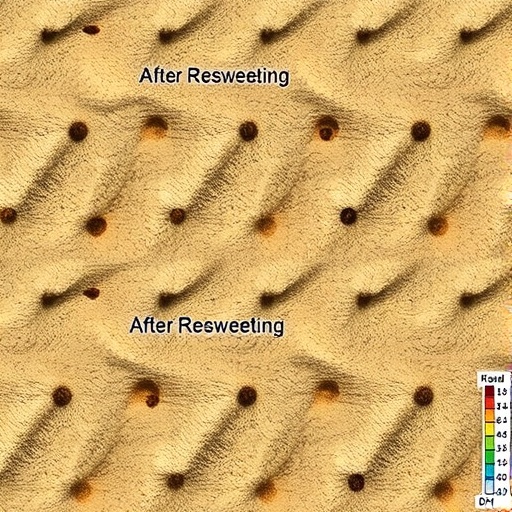Recent findings in soil science reveal an intriguing aspect of carbon emissions in sandy soils following rewetting events. A pivotal study conducted by Liu and colleagues, published in Communications Earth & Environment, identifies abiotic processes as the primary drivers behind short-term carbon emissions from sandy soils. This research emphasizes the critical interactions between soil moisture dynamics, atmospheric conditions, and microbial activity, providing fresh insights into peatland and other carbon-rich ecosystems. Understanding these relationships can substantially enhance our approaches to mitigate climate change through improved soil management practices.
Sandy soils, typically characterized by their large particle sizes and low nutrient content, have often been overlooked in carbon emission studies. The prevailing belief was that biological activity played a dominant role in regulating carbon release. However, the innovative investigation led by Liu et al. challenges this notion. Their research underscores that abiotic processes, such as mineral interactions and soil structural changes upon rewetting, significantly influence carbon dynamics in these environments. This revelation presents a paradigm shift in how scientists perceive and model carbon emissions from sandy soils.
The researchers conducted a series of rigorous experiments, simulating rewetting scenarios in controlled environments to observe the subsequent carbon emissions. Their meticulous measurements captured the immediate effects of moisture reintroduction on carbon release. Surprisingly, their data indicated that physical and chemical reactions, rather than biological activity, were predominantly responsible for the heightened emissions observed in the days immediately following rewetting. This disconnect between expected biological responses and actual findings highlights the need for further research into the abiotic mechanisms at play.
One critical finding from Liu et al.’s study was the role of soil mineralogy. Sandy soils, composed largely of quartz and other stable minerals, showed significant changes in their chemical composition post-rewetting. The interactions between soil particles and water molecules initiated processes such as leaching and desorption, which released previously stabilized carbon compounds back into the atmosphere. These findings underscore the importance of mineral content in predicting carbon behavior following hydration events.
Additionally, the study found that environmental conditions, such as temperature and atmospheric pressure, further modulate the extent of carbon emissions from sandy soils during rewetting. For instance, warmer temperatures seemed to enhance the rate of carbon release, indicative of the complex interplay between soil temperature and moisture levels. This interaction suggests that climate change, characterized by more frequent and intense precipitation events, could significantly affect carbon fluxes from these ecosystems in the future.
The implications of this research are profound, especially considering the global context of climate change. Increased understanding of the mechanisms driving carbon emissions from sandy soils presents new avenues for mitigating greenhouse gas emissions. By adjusting land management practices to account for the abiotic factors influencing carbon dynamics, landowners and policymakers can better manage soil health and promote carbon sequestration.
Another key aspect of the study is its contribution to understanding the feedback mechanisms between soil and atmospheric carbon levels. As sandy soils release more carbon during rewetting, they can contribute to a cycle that exacerbates climate change. Recognizing this feedback loop is vital for developing effective climate strategies and emphasizes the need for an integrated approach to soil management.
The findings from Liu et al. also highlight the necessity for soil scientists to reevaluate existing models used to predict carbon emissions and sequestration. Current models primarily focus on biological processes without adequately incorporating the role of abiotic factors. This oversight could result in significant underestimations of carbon emissions in sandy and other soil types, rendering climate predictions less reliable.
Furthermore, the research illustrates the importance of conducting localized studies to better understand the specific dynamics of various soil types. As soils across different ecosystems respond uniquely to environmental stimuli, tailored research is essential for developing precise models that can guide policy and educational initiatives. By gathering data across various regions, researchers can build a comprehensive understanding of global soil carbon cycles.
In conclusion, Liu et al.’s research stands as a significant advancement in the field of soil carbon dynamics. Their unearthing of the predominance of abiotic processes following rewetting in sandy soils challenges long-standing assumptions and opens new lines of inquiry within soil science. As the effects of climate change continue to unfold, it is crucial that researchers and policymakers alike heed these findings to develop more effective strategies for managing soil resources and mitigating climate change impacts.
In summary, the revelation that abiotic processes govern short-term carbon emissions in sandy soils opens new doors for research and practical applications. By re-examining the interactions taking place within soils, particularly in response to hydration events, scientists can refine their understanding of carbon cycles and contribute to a more sustainable future.
Subject of Research: Carbon emissions in sandy soils following rewetting
Article Title: Abiotic processes dominate short-term carbon emissions in sandy soils following rewetting
Article References:
Liu, F., Zhu, K., Wang, Z. et al. Abiotic processes dominate short-term carbon emissions in sandy soils following rewetting.
Commun Earth Environ 6, 733 (2025). https://doi.org/10.1038/s43247-025-02733-z
Image Credits: AI Generated
DOI: 10.1038/s43247-025-02733-z
Keywords: Carbon emissions, sandy soils, abiotic processes, rewetting, soil dynamics, climate change, soil management.




